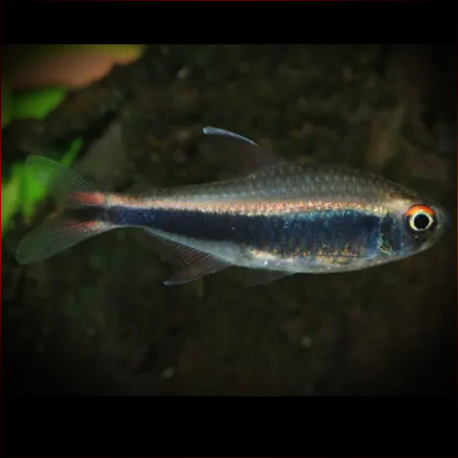More info
Datasheet
| Minimum Tank Size | 60 litres / 15.85 US gallons |
| Maximum Size | 4.0cm / 1.57inches |
| Temperature | 22°C / 71.60°F - 27°C / 80.60°F |
| Hardness | 2.02dgH / 36ppm - 10.03dgH / 179ppm |
| pH | 5.0-7.0 |
General Description
The Hyphessobrycon Peruvianus, commonly known as the Peruvian Tetra, is a species popular in the ornamental trade, sometimes confused with similar-looking congeners. It can be identified by its elongate shape, body depth, and characteristic coloration patterns distinct from other species within its genus.
Aquarium Setup
For optimal care, the Peruvian Tetra thrives in a community aquarium setup with similarly-sized species like characids, gasteropelecids, and certain catfishes. They prefer a mixed-sex group of at least 8-10 individuals, along with other schooling fish for security. The ideal tank should have sandy substrate, driftwood, leaf litter, and dim lighting. Water conditions with a pH of 5.0-7.0, hardness of 36-179ppm, and a temperature range of 22-27°C are recommended.
Behaviour
Known for its peaceful demeanor, the Peruvian Tetra is a great addition to community aquariums. When kept in a suitable environment with companions of similar size, the fish exhibit natural schooling behaviors, enhancing the visual appeal of the tank.
Feeding and Diet
As opportunistic omnivores, Peruvian Tetras feed on aquatic invertebrates, fallen fruit, and various small live or frozen foods in captivity. A diet comprising bloodworms, Daphnia, Artemia, high-quality flakes, and granules with plant or algal content is recommended to maintain their best condition and vibrant colors.
Reproduction & Dimorphism
These egg-scatterers show no parental care during reproduction. Adult males display slightly more intense coloration, while females tend to grow larger, especially when gravid. Breeding these tetras may require specific conditions such as appropriate water parameters and suitable breeding substrate.
Habitat and Distribution
Endemic to the upper Amazon basin in Peru, the Peruvian Tetra is found in various river systems including the Amazonas-Solimões, Maraņón, Napo, and Ucayali. Their natural habitat consists of small, shallow tributary streams with overhanging vegetation, submerged branches, and stained tea-colored water due to organic matter.

